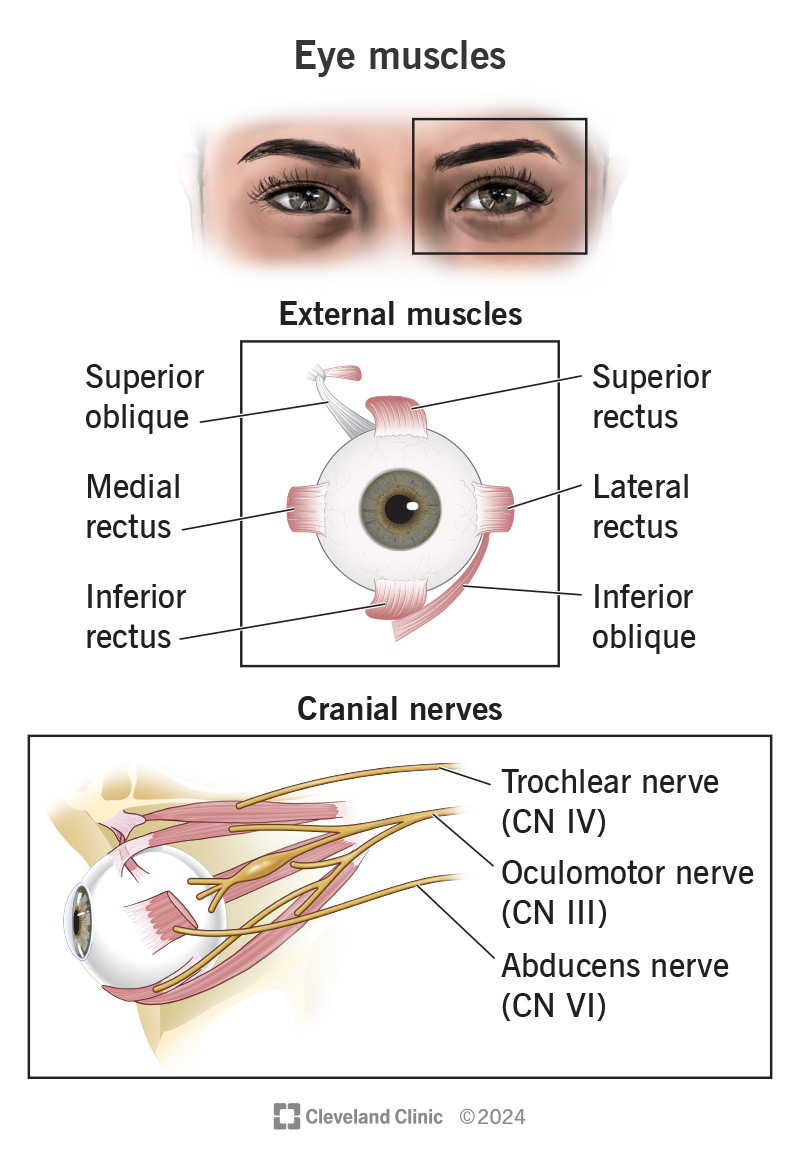If you’re reading this sentence, your eye muscles are hard at work. They control which way your eyes point, and they’re a key part of how your vision works. If your eyes aren’t moving properly, eye muscle conditions could be the cause. And eye movement disorders are crucial clues to many conditions, including some dangerous ones.
Advertisement
Cleveland Clinic is a non-profit academic medical center. Advertising on our site helps support our mission. We do not endorse non-Cleveland Clinic products or services. Policy

Both of your eyes have six muscles that control movement. These muscles are how you can direct your eyes side-to-side, up and down or at diagonal angles. The muscles that control eye movement all attach to the outside of your eyeball, which is why experts sometimes refer to them as “external” or “extrinsic” muscles.
Advertisement
Cleveland Clinic is a non-profit academic medical center. Advertising on our site helps support our mission. We do not endorse non-Cleveland Clinic products or services. Policy
While the external muscles mainly control which way your eyes point, they also play a role in how well you see. Your eyes need to move in ways that synchronize. If they don’t, you won’t be able to use certain visual capabilities like depth perception and three-dimensional (3D) vision.
There are two types of muscles, the rectus muscles and oblique muscles.
Each eye has four rectus muscles. Their names and locations are:
Each eye also has two oblique muscles.
Advertisement
The six external muscles of your eyes work in pairs. When one muscle moves, its partner in the same eye helps control and balance that movement. That’s why your eyes can only turn so far.
There’s also another type of paired movement that happens involving both of your eyes. Experts call this “yoking” because your eyes turn together like a pair of horses or oxen yoked together. That’s how your eyes turn in unison.
The muscles that control your eye movement depend on signals that travel through three cranial nerves:
There are two main forms that eye muscle conditions can take:
Your eye muscles are also vulnerable to injuries of the eye, skull or other surrounding tissues. In some cases, eye muscles can get stuck in the crack of a skull fracture. That’s called “entrapment,” and it’s a medical emergency. It may need immediate surgery to prevent permanent damage or other serious complications.
Some of these conditions are diseases that directly weaken muscles. These conditions can be ones you inherit, or they can develop spontaneously (either before you’re born or at some point during your life).
Examples of muscle disorders that affect eye movement include:
Your eye muscles depend on the nerves that link them to your brain. Conditions that damage any of the three cranial nerves or your brain itself can affect how you move your eyes.
Cranial nerve palsies are a specific type of nervous system-related muscle disorder. They can affect any of the three cranial nerves, but sixth (abducens) nerve palsy is the most common form. You can have some of these at birth, but most of them develop at some point during your life (usually because of an injury or other condition).
Other nervous system-related disorders that can affect eye movement include:
Advertisement
The most common symptoms of eye movement conditions include:
Some symptoms happen because your eyes can’t align properly or move in sync with each other. Examples include:
One of the most useful tools for checking eye muscle function is a neurological exam. Part of a neurological exam involves making you move your eyes in specific ways. If your eyes don’t move or react as they should, that can be a key clue to finding and diagnosing an otherwise invisible condition.
There are also a number of lab tests that may help diagnose eye muscle disorders. These usually involve blood tests, looking for specific antibodies or other markers. Thyroid disorders and immune diseases are both examples of condition types where lab tests are key for a diagnosis.
Advertisement
The treatments for eye muscle disorders vary widely. Some of the conditions that affect your eye muscles will get better on their own. When an eye movement issue happens because of an underlying condition, treating that condition may be enough to resolve the eye movement issue, too.
Some eye movement conditions need more direct treatment. Some treatment options include:
Your eye care specialist or another healthcare provider can tell you more about the treatment options available for your specific case. They can tailor that information so it lines up with your medical history, personal needs and preferences.
The main things you can do to help preserve and maintain eye muscle health are:
Advertisement
Eye movement issues can be signs of very serious conditions, including some that are dangerous or deadly. If you have trouble moving your eyes under any of the following circumstances, you should get emergency medical attention:
A good rule of thumb to remember is when in doubt, don’t delay treatment. Quick diagnosis and treatment can make a huge difference in the outcome of your situation.
If you’re reading this page, thank your eye muscles. They’re helping you follow along from word to word. Eye muscles are a huge part of how most people go about their lives, but it can be easy to take them for granted.
Protecting your eyes from injuries is key, and regular eye exams are also important. And be sure not to ignore any symptoms that seem to involve your eye muscles, even if they don’t seem serious or severe. Taking good care of your eye muscles is a great way to make sure they keep directing you where you need to look and go.
Getting an annual eye exam at Cleveland Clinic can help you catch vision problems early and keep your eyes healthy for years to come.

Last reviewed on 10/12/2024.
Learn more about the Health Library and our editorial process.